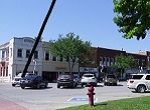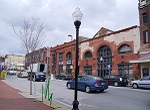Retail Attraction Strategies for Bringing in Stores You Want
Last Updated: January 27, 2021
If you have been emphasizing retail attraction as the salvation for your downtown area or neighborhood business district, it's time for some serious attention to strategy. Online shopping has now taken a market share that would have been unthinkable just a few years ago, and of course the pandemic greatly accelerated that trend.
In addition, big box stores continue to grab another large share. The increasing popularity of delivery and outside pick-up services during the coronavirus pandemic has even robbed retailers of impulse purchases at the cash register.
Now the only type of retail attraction efforts I can counsel neighborhoods and cities to pursue fiercely is what is called experiential retail. You probably can think of a few stores, past or present, that are just pure fun to visit and browse.
If a good nucleus of your sole proprietors or family businesses are still solvent, of course it is quite worthwhile to try to fill storefronts as they become vacant. This is especially true in ethnic neighborhoods where local proprietors can take advantage of shared language and cultural meanings.
Regardless of how that turns out, in most places chain stores have been steadily infiltrating areas that once were completely family business dominated, so many of you have been asking us questions about how to convince new stores to locate in your areas.
In theory you wouldn't have to worry about retail attraction in a market economy. Goods and services do "follow rooftops," meaning that when the residential, student, or employee market is sufficient, hamburger joints and grocery stores will follow.

However, all markets are inefficient to some extent. Neighborhoods that are borderline in disposable income and lacking in residential density may not succeed in attracting the neighborhood commercial enterprises they want.
In those neighborhoods, you will need to substitute offices, small-scale manufacturing, and even conversion to housing in spaces that formerly held retail. In markets that are too saturated, you may need to convert some retail space to sports-oriented activities or performance space. If buildings have become dilapidated enough to need major reinvestment, your community may face the prospect of demolition and then the creation of a nice park.
But just for purposes of this page, let's talk first about attracting chain stores.
It may be just an oversight or bad luck that your community does not have a Biggest Burger Chain that it desperately wants, when market research would show that there are enough buyers and enough income present to support one.
Or the community may specifically want Strong & Stronger Coffee, even if coffee is readily available in many other places.
I always think it is worth contacting that much-desired chain, since your contact will be virtually cost-free. Most of them have more location opportunities on the horizon than they have money or time to invest. If it's a tie among six or eight cities or neighborhoods, the personal contact could be a tie-breaker.
Granted, it may not be easiest thing to call Strong & Stronger and actually wind your way through the chain of telephone referrals to find an appropriate person who is willing to talk with you. But it's not impossible, so ask the most persuasive and persistent person in your community to make those calls.
If you send a signal that the purpose of your retail attraction call is to set up an aggressive sales campaign, to harass if you are told no, and to generally become indignant and abusive if you are denied, you will not get very far.
However, if you seem reasonable, courteous, and willing to hear the truth, you eventually will find a person with whom you can speak by phone or e-mail. The purpose of the first meaningful call or e-mail should be to establish your interest in their company, explain that you are taking new initiatives in your town, and attempt to obtain a face-to-face interview or set up a tour for them.
But eventually with Strong & Stronger, and every other chain, you're going to hear the truth. Either you meet their criteria or you don't. Your persistent but pleasant personal contact may tilt them in your direction if you're on the borderline, but if you're way below the number cruncher's criterion, you're not going to win.
If they can't borrow the money, your pleas will fall on deaf ears.
So if you strike out with chain stores, we recommend supporting local entrepreneurs. In these days of mammoth mergers and bankruptcies, local companies may be a better bet anyway.
If your neighborhood or downtown area emphasizes mostly mom and pop stores, you can increase the likelihood of their survival if you can convince and coach them to become more experience-oriented. Maybe they can offer cooking classes, or a unique play space for the children, or a barrage of readings or performances if they sell books, or even some videos or talks about how and where their products are made. Perhaps they can teach crafts, hold trunk shows, hire a pianist for Saturday afternoons, or have a midnight pajama party. They may be doing these things already, but they need to constantly reinvent the events to become experiential retail stars.
The mom and pop stores may be fine for the next few years, providing these businesses are handsome and well run.
The Personal Touch in Retail Attraction
Fortunately, many businesses are not chains. You can find them, expand them, convert them, or divert them. If you're in a metropolitan area, find the business you'd like somewhere else in the city.
If you're outside the metro area, take a trip to the big city and find your ideal operator there. If you're already in a big city and you see a retail operator you'd like in a nearby city, approach that businessperson about an expansion to your market.
Target what you want, but be smart about it. In addition to population and disposable income, local tastes influence what retail businesses will thrive. This applies even in larger cities, where obviously there may be enough income and population to support a particular type of store.
However, if the residents prefer traditional furniture and architecture, even a large city will not support many contemporary cutting-edge furniture stores. So don't invest a lot of effort in retail attraction that is doomed to failure.
Consider instead whether you could cultivate a business that is only a small step up from what you have already, but a step in the right direction. You could gradually upgrade the commercial offerings for your townspeople as well as tourists and day trippers who might patronize the new businesses.
When you find that ideal store, contact the owner personally. Go through the manager if you must, but your decision maker is the person with the money behind the business. Get an appointment to visit with the owner and explain your seriousness about your business district and retail attraction.
Be very polite but let them know you want them to keep thinking about you, and try to be really engaging as you say you won't take no for an answer.
Cultivate Entrepreneurs
Already you know that the very best in many aspects of economic development is to grow your own entrepreneurs. In many communities a number of women harbor the dream of having their own little boutique, so if you live in a place where there are some women of leisure, try particularly to connect them to a women's businessperson association that can provide support and information for would-be women entrepreneurs.
We all know that many women
do a lot of the shopping, and I bet they do a very high proportion of
the daydreaming about shopping!
If you have a small business development center nearby, meaning it's within a two-hour drive, invest a modest effort in publicizing its services to would-be entrepreneurs in your midst. This might result in a new business for you.
Retail attraction from outside the immediate neighborhood needs to be balanced with the sometimes more realistic notion that people who already are invested in your community will be the most devoted to a business there. In general, check out our page on entrepreneurship support.
We must caution that we are not in any way implying it will be easy to compete as a new retail establishment, considering the dominance of online and big box retailers. However, the very best candidates for entrepreneurship may find a way to make it work, even in retail.
If we sound lukewarm about putting community effort into attracting retail entrepreneurs, you are reading us exactly right. There's an exception though, and that of course is restaurants. Most commercial districts should not turn themselves into solely a restaurant district, in our opinion, but on the other hand, all retail districts need some restaurants. This is where your best skills in helping entrepreneurs need to be brought to bear.
Retail Attraction for an Entire Business District
|
Suppose that you have a whole business district that needs to be upgraded. This need for commercial district revitalization applies to many historic downtown neighborhoods. The Main Street program of the National Trust for Historic Preservation remains an excellent resource for downtowns, and other business districts can benefit from understanding their approaches as well. One of their four pillars is economic restructuring. One approach to reviving a business district that we've seen work is the "I will if you will" retail attraction program. If you want to make a substantial leap upward in your business base, and for example, replace tacky souvenir shops and tourist traps with quality place-relevant businesses, put together a plan that shows a phased approach to how you plan to accomplish the goal. For a beach town, phase 1 might include relocating all of the tacky tourists traps to an off the beaten path location away from the beach. Or you might choose only one or two of the biggest offenders, and try to convince them to either upgrade their external appearance and their merchandise quality, or to move to other less prime real estate. Sometimes removing only one or two major eyesores is all that is needed to upgrade the atmosphere of a place. Now move on to the "I will if you will." Put together a campaign
that shows all available (or soon-to-be-available) locations where you
would like a group of desirable businesses. Then put together a list of
specific businesses or operators, if known, or write down the type of
operation you are seeking in as much specificity as you can muster.
|
These businesses might be desirable because they are export businesses (that is, tourist-oriented or somehow able to draw in outside income) or because they meet a need of the locals or of the export businesses you do have.
If you see infrastructure needs, tax incentives, code enforcement, or other problem-solving that the public sector needs to do, negotiate and write down the timetable for when the public sector will provide those items.
Then you are ready to visit businesses. Under this approach, try to obtain a commitment not necessarily to move to your location right now, but rather a firm commitment to move when certain other conditions are met.
Usually this would be, for example, when you have four of the target businesses committed to the "I will if you will" campaign, each of them pledges to move, or ideally to establish a new location.
This approach to retail attraction accomplishes the following:
- You are lessening risk for the in-moving businesses, because their upgraded business will be part of a more general approach.
- You are creating massive excitement in the community when suddenly several businesses appealing to the same clientele or income level appear at about the same time.
- You are generating the ability to attract considerable attention from the press because of the sudden shift.
- You are creating an instant support system for the new businesses.
- You have thought in advance about what will happen to the businesses you are displacing.
- You blunt some of the criticism about driving away or moving less desirable businesses because nearly simultaneously, you bring in new business through the retail attraction program.
Try this approach, as opposed to a more incremental approach, if you have abundant space and something good to sell, as all downtowns do.
Incidentally, before you undertake such a thing, find yourself a very talented social media spokesperson or influencer who can really create buzz (and short videos) about your business district. You can even have a TikTok content for the teenagers in the summer. You might be surprised at how clever they can be.
Creative Approaches to Building a Retail District
Is yours just too small a market or market share to attract everything you want? Think really outside of the box.
For just one example, Eskender Aseged, San Francisco's "Nomadic Chef," started a project in 2004 of temporary restaurants when that was still a novel idea. This idea of "pop-up" restaurants has spread like wildfire in American cities, but now there are other types of pop-up retail and flexible shared uses of retail space as well. It's also a good way for existing restaurants or stores to try a new concept or test your market.
Think about multiple business purposes being served within the same space. Sometimes an existing breakfast and lunch restaurant might be leased out to a dinner-only restaurant to share the space, for example. Maybe a coffee shop accustomed to closing at 2 p.m. becomes a dinner buffet at night. A restaurant ordinarily closed on Sundays and Mondays becomes something really gourmet and interesting on Sundays and Mondays--something that wouldn't have a full-time following in your market for a 5-7 day a week might make it only one or two days a week.
Leaving aside restaurant examples, maybe a kitchenware store becomes a kitchenware and specialty garden shop so that multiple family members will enjoy the retail destination. If you downtown or commercial district is really quite small, think about the antique mall model, in which you essentially rent stalls to particular retailers that have something interesting and unique to offer.
We want to add a final note of caution about retail attraction. In your zeal to fill retail space, be sure to investigate how each store will actually operate. Beware of the "dark store" phenomenon, which is a small but growing trend. In a dark store, only the employees roam the aisles picking up the items that customers have ordered online. Obviously this would result in very little of the street life that caused you to want retail stores in the first place. We mention this as one example of retail trends that you should track if you are a merchant or merchants' association representative trying to beef up your business district.
With the trend toward ordering online and picking up in the store, some stores operate more and more like part-time warehouses. But at least a warehouse has a limited number of large vehicles entering and leaving, but a big box retailer has many individual passenger vehicles picking up packages or returning packages, as the case may be.
If you've done something novel in the way of retail attraction, you can tell us about it at our community improvement projects page.
More Reading About Community Retail
- Making and Keeping a Good Community >
- Community Challenges, Common Topics & Concepts >
- Economic Development > Retail Attraction for Communities
Join GOOD COMMUNITY PLUS, which provides you monthly with short features or tips about timely topics for neighborhoods, towns and cities, community organizations, and rural or small town environments. Unsubscribe any time. Give it a try.





